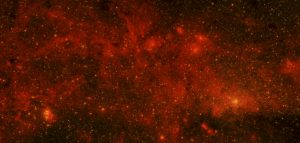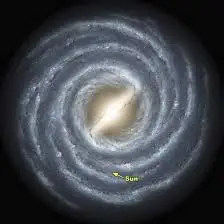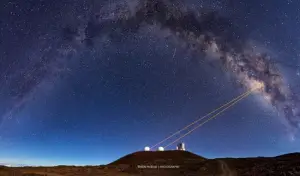
When I look up and see the Milky Way galaxy, am I looking towards the center of the galaxy or towards outer space?
Tell me a good astronomy joke while you’re at it.
That is a great question! In fact, you are generally looking into the DISC of the Milky Way galaxy. I’m sure you’ve seen some images, which are really just artists’ concepts, of what our galaxy looks like. From a face-on view it looks a little something like this:

And from an edge-on view it looks a little something like this:

Again, these are not actual images of the Milky Way, just what it might look like. Given our location inside of the Milky way, it is impossible for us to take on image of our own galaxy!
So the Milky Way is a big frisbee-shaped disc that has these spiral-arm structures winding their way from the center to the outskirts. The Earth sits within this disc, and so when we look up at the night sky, the Milky Way appears as a long “milky” strip running across it. The center of the galaxy occupies only a small portion of the entire strip and can generally only be seen if you are in the southern hemisphere. Here’s an image where the lines are pointing to the center:

As far as outer space goes, it depends on what you consider “outer.” Some would call just a few dozen miles above the Earth’s surface outer space (check out the definition of the Karman Line). But certainly, if you want to look as far as humanly possibly, don’t look into the milky strip of the galaxy where all sorts of dust, gas, and debris will cloud your vision, but rather into the seemingly dark and empty regions surrounding it. Here, if the viewing conditions are especially good, you can see things like the Small and Large Magellanic clouds and, if you’re very lucky and have very good eyes, Andromeda Galaxy. These are the only three objects visible to the naked eye which are not a part of our own galaxy. The Magellanic clouds are dwarf galaxies orbiting the Milky Way, and Andromeda is our nearest galactic neighbor, 2.54 million light years away, the most distant object visible to the naked eye!
Anyways, sorry if you expected a brief answer, but if you ask an astronomer about astronomy, you’re bound to get a long and passionate response!
Astronomy Joke:
How do you organize a space party? ……. You Planet!
Zach Vanderbosch
UT Austin
